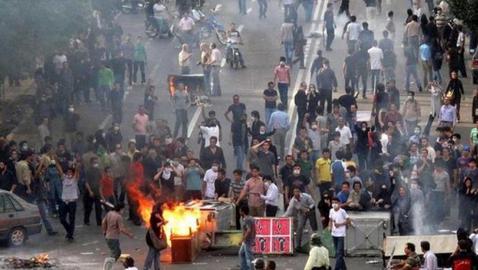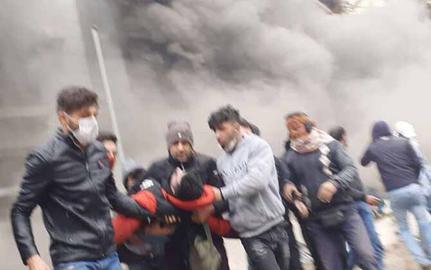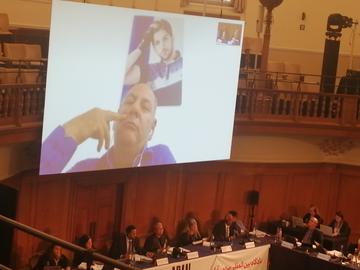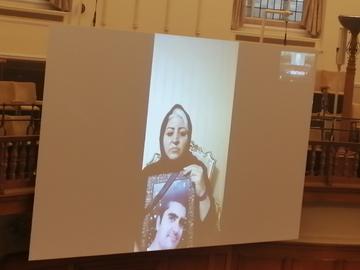“My son’s work was installing porcelain tiles. He came home from work at 1pm, then went back out at 1.30pm. Unfortunately, we lost him.”
It’s 12.30pm local time in a dank, overcast London. In the main chamber of Church House, a stone’s throw from Westminster Abbey, the man introduced as Witness 34 is recounting the Iranian state’s murder of his son on November 16, 2019.
The day before Farzad Ansarifard lost his life at the age of 28, Iranian authorities had announced a threefold hike in gas prices: a decision taken by the three branches of power without public consultation. Coming as it did during a time of worsening economic crisis, the measure sparked outrage; small businesses faced the prospect of being eliminated overnight. The next day, massive spontaneous protests broke out in at least 40 cities.
On Saturday, November 16, top officials including Supreme Leader Ali Khamenei and then-President Hassan Rouhani attended a behind-closed-doors, emergency meeting of the Supreme National Security Council. No minutes are available detailing what was said, or by whom. But after decisions taken in that room in Tehran, the internet was cut off starting from 2pm on Saturday. By 7pm on Sunday, Iran was in a complete internet blackout. Lethal violence ensued, with between 300 and 3,000 Iranians killed by the police and security forces. Officials and state media called the victims “rioters”; their families were threatened and, in many cases, silenced. Thousands of others were jailed and tortured, and are languishing in prisons across the country to this day.
Farzad Ansarifard was killed around the time the blackout was being imposed. His name echoed across the chamber in London on Wednesday at the outset of the Aban Tribunal: an independent, expert-led people’s tribunal establishing accountability for the crimes of November 2019. Farzad’s father, Amin Ansarifard, was the first witness to be called. Appearing via videolink from Behbahan, Khuzestan province, he is one of the handful of Iranian citizens who asked for their real names to be given during public hearings, despite the threat to their lives that speaking out could pose.
“Several times,” Ansarifard said, “we said the individual who killed our son should be introduced to us. Maybe it was an enemy. Maybe someone intentionally killed our son. They gave us no answer. They said they didn’t know.”
Farzad was 150m away from the family home when, as a postmortem in Ahvaz later showed, he was shot dead at a distance of 40m with an 8mm bullet from a Kalashnikov. It took relatives five hours to locate him at a hospital morgue in Behbahan. There, Ansarifard said, he saw the bodies of six other people killed that day – and the face of his own, slain child. “The injury was behind his head, on his neck,” he said. “They had shot him there, and the bullet had come out of his upper lip. It had come out of the left side of his face.
“Officials prepared the corpse [for burial]. They did it all themselves. Usually the family receives the body and does what’s needed before the burial. But they just handed him over to us and said: ‘Bury him’. At the time, the situation was dire and we didn’t understand what as going on. We were given no decision as to where to bury our child.”
The family lodged an offiicial complaint, but never received so much as a confirmation of receipt from the court. Last November they were barred by security agents from commemorating Farzad’s death on the pretext of Covid-19. In the interim, both his uncle and sister Farzaneh were detained on charges of “propaganda against the regime” for speaking out about the killing. “They told us to keep it quiet,” Ansarifard said, “and not to tell anybody.”
“Victims Have a Right to Know”
The five-day Aban Tribunal was principally organized by Justice for Iran, Iran Human Rights and Together against the Death Penalty (EPCM) working with tens of Iranian victims, eyewitnesses and their families. It will try to establish whether international crimes – such as murder, torture or enforced disappearance – were committed by state actors in Iran in November 2019, and if so, who is responsible. The findings, due to be announced in early 2022, will give the Iranian people a permanent record of what happened in November 2019 and in the aftermath. The welter of evidence and expert opinions collected this week could also be used in future litigation.
Opening proceedings on Wednesday, international human rights lawyer Wayne Jordash QC of Doughty Street Chambers said that in November 2019, serious crimes had been observed in at least 15 Iranian provinces and 39 cities. “As is universally accepted,” he said, “international crimes and mass violations of human rights should not go unpunished. Victims are entitled to accountability, justice and reparation. They have an inalienable right to know the truth.
“The Islamic Republic has taken no steps to initiate legal or judicial proceedings to determine where responsibility lies... This [the Tribunal] has been made necessary due to the failure of both the Islamic Republic of Iran and international justice to provide the victims with any established, institutional procedure in which the facts may be assessed, and their suffering acknowledged.”
A total of 275 people – of whom all but 22 are still inside Iran, and who hail from 47 different Iranian cities – responded to a public call for information from the organizers 12 months ago. Of these, the witness statements of 145 were recorded and painstakingly verified by co-counsel. Among the testimonies are eight from people who were party to inside information about how the regime responded to protests, as well as hospital doctors and medics who visited injured protesters at their homes.
The Islamic Republic of Iran did not make any representations. A total of 133 people were identified by the co-counsel of being responsible for crimes linked to the protests; their names are listed here.
Families Subjected to Degrading Treatment
New York-based human rights defender Masih Alinejad also took the stand on Wednesday afternoon. The firebrand activist previously made a documentary featuring 25 November 2019 victims’ families, some of whom lost more than one child. “Instead of me,” she said, “I wish all those mothers who would like to testify, whose children were shot in the heads and chests, were sitting here.”
Alinejad pointed out that, contrary to what Rouhani, Khamenei, the Interior Ministry and other officials claimed, namely that those killed were armed “rioters”, in her experience most families said their loved ones had gone to the protests empty-handed. In at least two cases, she said, families had been asked to pay not just to receive their child’s body, but for the cost of the bullet.
Some of the videos sent to Alinejad by the mothers of young people killed were played in the chamber. Ebrahim Ketabdar, a 30-year-old father-of-two, was shot in the chest in Karaj as he was on the way home for lunch on November 16. His mother Sakineh Ahmadi said: “My grandchildren are without a dad now. Wherever I go, even to the court, they don’t tell me who the murderer is. The last time I went to the court, I said, ‘You killed my son two years ago, say something’. They kicked me out.”
Mahboubeh Ramezanifard, mother of Pejman Gholipour, who was killed in Karaj aged just 18, said: “They’re threatening me. They say I shouldn’t be inquiring about my son’s murder, that I should stop telling people what happened. I celebrated Pejman’s 20th birthday this year. It was held in his grave.”
In an unexpected turn, the panel also received a first-hand testimony from the mother of Pouya Bakhtiari, 27, who was killed by a gunshot to the head in Karaj on November 16, 2019. After being sworn in via videolink, Nahid Shirpiseh explained how she and her son had been separated in the crowd an hour and a half after joining a street march. The next time she saw him, bystanders were carrying his body. Both of Pouya’s parents were arrested in April this year for speaking out about the killing, and his father, Manouchehr Bakhtiari, is still in Karaj Central Prison.
“My son was calm,” Shirpiseh told the tribunal. “He loved peace and the environment. He was well-educated. He did sports. We went without anything in our hands [unarmed] to a civil protest, which is a basic right. That evening I saw the Guards with weapons. But I never thought they would use them as tools to kill Iranians.”
The day’s final witness was a young woman in Iran named only as Witness 32, who concealed her identity with a mantle, sunglasses and a mask as she testified about the killing of her older brother. He was shot in the stomach on November 16, and his body was then withheld from the grieving family for two weeks. Even on the night of his death, she said, "They also shot at everyone around him so no one could approach him. He was in the rain for an hour."
The family lodged a complaint and since then, Witness 32 said, her younger brother had received multiple death threats from officials while her parents fell into a deep depression. “A year and a half later,” she said, “when the verdict came back, they [the court] said: ‘It was the Basij that killed him, and you are not allowed to pursue the matter.’
“He was 25 years old and in his own country. All he was entitled to was a bullet. What was his crime? For what sin did they kill him? I am here because I want to see justice for the blood of my brother. Our rights shouldn’t be trampled on.”
Related coverage:
Hundreds Testify in "People's Tribunal" on November 2019 Atrocities
Aban Tribunal: 133 Iranian Officials Accused of November 2019 Crimes
Tanks and Machine Guns Used to Subdue People of Mahshahr
Heavy Machine Guns Used to Kill Protesters
visit the accountability section
In this section of Iran Wire, you can contact the officials and launch your campaign for various problems






























comments